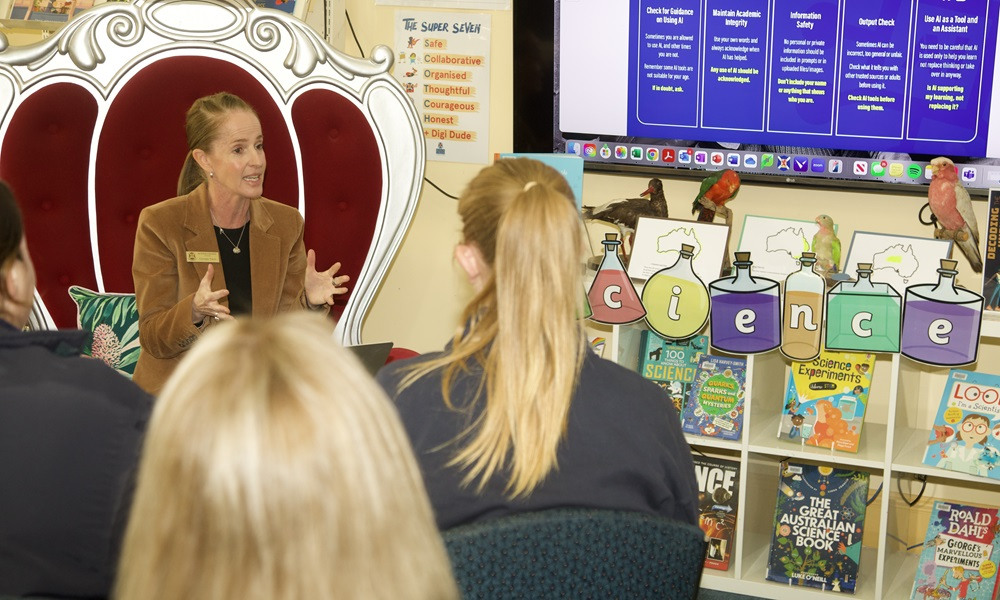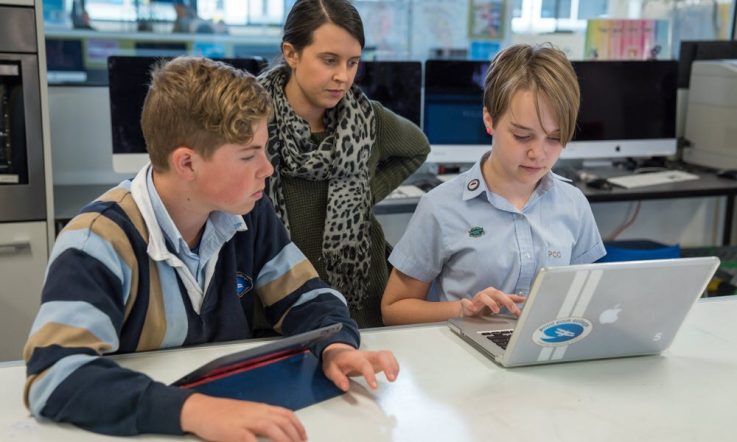‘Staff are integrating AI into their practice in ways that align with their readiness, confidence, and classroom context.’ In today’s article, Georgie Facci, year 6 teacher and Team Leader at Scotch College Junior School, Adelaide, shares how the school is embedding AI into the teaching and learning across the curriculum, and how staff are building their confidence and capabilities to foster a culture of empowered experimentation.
In the ever-evolving landscape of education, the integration of generative AI is no longer a distant concept; it is a present, powerful force reshaping how we teach, learn, and lead. At Scotch College Junior School, Adelaide, our journey with AI has been one of curiosity, collaboration, and capacity-building. What began as a spark of experimentation has grown into a dynamic, school-wide movement, empowering both students and staff.
My own journey with this technology has been anything but linear. In 2018 when I first joined the Digital Technologies team, I often felt uncertain, tentative in a space that seemed highly technical and constantly shifting. I wasn’t always confident. But through deep curiosity, sustained experimentation, and an openness to learning from colleagues within and beyond the school, I found my footing. One of the most liberating insights has been this: no one is ever truly an ‘expert’ in this space. The landscape evolves too rapidly. What matters is a willingness to explore, reflect, and generously share.
That mindset has shaped the evolution of my leadership role. Initially part of a broader Digital Technologies team, I transitioned into a dedicated AI Specialist position in 2024 as an opportunity opened to explore the AI space. This shift was a decision by the Digital Technology Leadership team, driven by evolving school needs, ensuring expertise was available where it was most needed in the early stages of development. The role also allowed for clear, intentional expectations and goals, aligning AI initiatives with teaching, learning, and strategic priorities.
This year, the role evolved into Teaching and Learning AI Specialist, reflecting our commitment to embedding AI across the curriculum. I teach in a year 6 classroom 4 days a week and serve as Team Leader, with one day as year 3/4 Stage Coordinator. The AI role has no formal time allocation but integrates with these positions, allowing me to connect with all learning stages and guide others in this developing space.
In addition, I work closely with Dr Nick Jackson, Leader of Digital Technologies at Scotch College. My responsibilities, mainly in the Junior School, include promoting ethical AI use, introducing innovative student-friendly tools, and embedding AI into curriculum planning. I model AI practices in the classroom and present insights that align with Scotch College priorities.
An annual Junior Campus staff survey and student survey shape our professional learning, ensuring relevance and responsiveness. Our aim is not just to introduce tools but to foster a culture of empowered experimentation – a safe space where curiosity, sharing, and collaborative learning thrive.
That culture is now embedded at all levels across the Junior School. Staff are integrating AI into their practice in ways that align with their readiness, confidence, and classroom context. Most commonly, Copilot, Claude, ChatGPT and Canva are used across all year levels and in multiple subjects to generate visual prompts and differentiated task sheets, create writing scaffolds and adapt resources for diverse learners.
The applications are purposeful, efficient, and grounded in pedagogical intention. These practices amplify teacher expertise, free up time, and support more inclusive and dynamic teaching environments.
AI in the classroom
In classrooms from Reception to year 6, students encounter AI not as a novelty but as a guided thinking partner – one that helps them generate ideas, explore concepts, and build language. Teachers model how to ask effective questions, evaluate AI responses critically, and maintain ownership of their ideas. We are mindful of age restrictions and therefore highlight generative AI options that are used in a guided or student-friendly manner.
I recently collaborated with a new year 6 teacher which led to a persuasive genre unit, with generative AI used for modelled texts, tiered activities, rubrics, task sheets, and curated multimedia. Effective prompting used clear, context-rich instructions defining format, purpose, and audience, supported by example structures and persuasive devices.
For example we asked: ‘Create a printable A4 Word document titled Exploring High Modality Words for Year 6, with tasks on modality spectrum creation, ranking, justification, and rewriting.’ Attaching guides and samples reduced prompt length and improved accuracy. Staff valued the depth of AI-generated tasks while curating and aligning them to curriculum goals. Students gained tailored tasks, richer examples, and scaffolded support that built confidence and deeper understanding. Now used by all year 6 teachers and supported through modelling and a Junior School presentation, the approach is holistic and embedded in planning and delivery.
AI’s value in differentiation is clear: it supports EALD (English as an Additional Language or Dialect) learners with simplified explanations, offers personalised scaffolds for additional needs, and provides extension and creative options for high-potential learners – making learning more equitable and responsive. This was clear when I pre-prepared tasks for 2 year 6 EALD students. Using generative AI, I simplified texts, created sentence starters, and developed vocabulary lists with clear definitions – supported by cloze and chunking exercises that boost comprehension and confidence. Many strategies adapt across year levels and learner needs.
Age and stage – examples from the classroom
Informed by recent professional learning, our approach at Scotch is grounded in Cognitive Load Theory (Sweller, 2011; de Jong, 2024) and Compassion-Focused Pedagogy (Teding van Berkhout & Malouff, 2023). These frameworks guide us in reducing teacher overwhelm while building sustainable practice. We’ve found that, by modelling manageable, high-impact strategies, like effective prompt design, we create low-risk, high-return opportunities for teachers to trial, refine, and reflect on use. To consolidate learning and build capacity, we invite staff to trial a tool or strategy after each professional learning session and then return to share reflections. This has helped our staff to build their competence and confidence over time.
I have actively shaped our school’s approach to generative AI, delivering staff presentations, modelling examples, and working one-on-one with teachers to support integration. I have trialled various tools and models in classrooms, using student interactions to fuel broader professional discussions.
Our approach to building staff capacity by trialing a shared AI tool is shown in a year 2 teacher’s response after a junior primary presentation. The teacher used Say What You See – an AI experiment by Google Arts & Culture – to improve students’ observation and descriptive language. The tool generates images from students’ verbal descriptions, encouraging precise language on colour, shape, texture, and details. The process supports vocabulary growth, clarity, and confidence. These skills enrich communication and deepen inquiry. This cyclical approach fosters growth, reinforces agency, and models an iterative, inquiry-based mindset.
For middle and upper primary students, the generative AI tool NewArc – a visual generator – enhanced descriptive writing in a historical narrative unit. Students made initial setting sketches, then crafted precise prompts to refine them. Comparing original sketches, refined prompts, and AI images side by side, students saw how precise language improves visuals. This modelling showed how precise language enhances storytelling, deepening understanding of setting and detail.
AI is also proving valuable in operational contexts beyond the classroom. A recent collaboration with our Early Learning Centre involved co-designing a more intuitive reporting system – reducing administrative load while enhancing clarity and communication. AI is not limited to teaching tools; it is an enabler of system-level efficiency and wellbeing.
Taking risks, nurturing curiosity, and conversations are key to navigating AI’s evolving landscape in education. Dr Jackson models ethical, age-appropriate AI use. Our talks sparked dialogue about age-appropriate tools, what students can explore alone, and what needs guidance. Our work is guided by ongoing dialogue with early adopters, experts, and professional development. Transparency with staff, students, and families is vital. A colleague called me their ‘canary in a goldmine’ – venturing ahead, testing terrain, and bringing back insights. This metaphor resonates.
That transparency led to the creation of our AI Generative Responsible Use Guide – a living document co-developed with staff and leadership and students. Designed as a visual poster, it outlines clear, practical, and age-appropriate expectations for AI use across year levels. This resource, displayed throughout the school, ensures our ethical stance on AI is visible and accessible. It also fosters trust and alignment within our broader school community.
Our work aligns with Monash University research (2023) urging educators to guide students in AI literacy while supporting equity, access, and digital citizenship. Monash stresses that explicit teacher modelling helps students understand generative AI and promotes responsible, ethical use in classrooms.
Creating space for gradual, meaningful adoption
We recognise that integrating generative AI requires more than technical training, and that teachers, parents, and the wider community are navigating unfamiliar territory – our aim is to create space for gradual, meaningful adoption.
While generative AI arrived quickly and continues to evolve at pace, it’s worth remembering that educators have always adapted. What’s different now is the speed and complexity of change; and the need to be proactive in shaping how AI supports, rather than dictates, educational practice.
At its core, this is deeply human work. Our experience shows that when used thoughtfully, AI doesn’t diminish the role of the teacher – it enriches it. At Scotch, that future is already unfolding with optimism, creativity, and a shared belief in the transformative power of learning, together.
References
de Jong, T. (2024). Cognitive load theory: Research that teachers really need to understand. British Journal of Educational Psychology, 94(1), pp.1–19. https://doi.org/10.1111/bjep.12636
Monash University. (2023). Fostering AI literacy: A teaching practice reflection. Available at: https://research.monash.edu/en/publications/fostering-ai-literacy-a-teaching-practice-reflection [Accessed 9 Aug. 2025].
Sweller, J. (2011). Cognitive Load Theory. Psychology of Learning and Motivation, 55, pp.37–76.
Teding van Berkhout, E. and Malouff, J.M. (2023). The effectiveness of compassion-focused therapy: A meta-analysis. Mindfulness, 14(1), pp.1–12. https://doi.org/10.1037/cou0000093
UNESCO. (2023). Guidance for generative AI in education and research. [online] Available at: https://unesdoc.unesco.org/ark:/48223/pf0000386093
As a school or team leader, are your staff already using generative AI tools? Does your school have guidelines about the use of these tools? What expertise already exists in your school? What supports do staff and students need?



